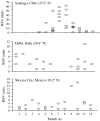The relationship of meteorological conditions to the epidemic activity of respiratory syncytial virus
- PMID: 17346359
- PMCID: PMC2870672
- DOI: 10.1017/S095026880600776X
The relationship of meteorological conditions to the epidemic activity of respiratory syncytial virus
Abstract
Our aim was to obtain knowledge of how meteorological conditions affect community epidemics of respiratory syncytial virus (RSV) infection. To this end we recorded year-round RSV activity in nine cities that differ markedly in geographic location and climate. We correlated local weather conditions with weekly or monthly RSV cases. We reviewed similar reports from other areas varying in climate. Weekly RSV activity was related to temperature in a bimodal fashion, with peaks of activity at temperatures above 24-30 degrees C and at 2-6 degrees C. RSV activity was also greatest at 45-65% relative humidity. RSV activity was inversely related to UVB radiance at three sites where this could be tested. At sites with persistently warm temperatures and high humidity, RSV activity was continuous throughout the year, peaking in summer and early autumn. In temperate climates, RSV activity was maximal during winter, correlating with lower temperatures. In areas where temperatures remained colder throughout the year, RSV activity again became nearly continuous. Community activity of RSV is substantial when both ambient temperatures and absolute humidity are very high, perhaps reflecting greater stability of RSV in aerosols. Transmission of RSV in cooler climates is inversely related to temperature possibly as a result of increased stability of the virus in secretions in the colder environment. UVB radiation may inactivate virus in the environment, or influence susceptibility to RSV by altering host resistance.
Figures




References
-
- Leader S, Kohlhase K. Respiratory syncytial virus-coded pediatric hospitalizations, 1997 to 1999. Pediatric Infectious Disease Journal. 2002;21:629–632. - PubMed
-
- Shay DK et al. Bronchiolitis-associated hospitalizations among US children, 1980–1996. Journal of the American Medical Association. 1999;282:1440–1446. - PubMed
-
- Sigurs N et al. Respiratory syncytial virus bronchiolitis in infancy is an important risk factor for asthma and allergy at age 7. American Journal of Respiratory and Critical Care Medicine. 2000;161:1501–1507. - PubMed
-
- Denny FW, Clyde WA., Jr. Acute lower respiratory tract infections in nonhospitalized children. Journal of Pediatrics. 1986;108:635–646. - PubMed
-
- Laham FR et al. Differential production of inflammatory cytokines in primary infection with human metapneumonirus and with other common respiratory viruses of infancy. Journal of Infectious Diseases. 2004;189:47–56. - PubMed
Publication types
MeSH terms
Grants and funding
LinkOut - more resources
Full Text Sources
Medical

